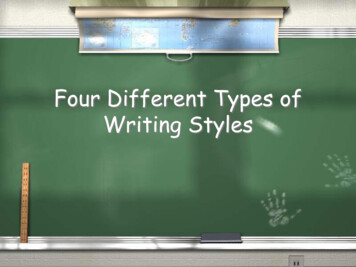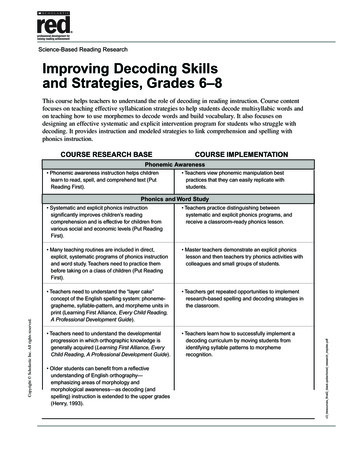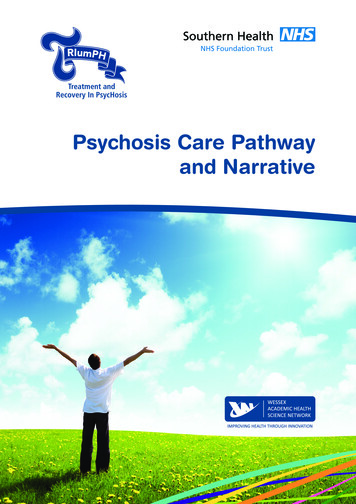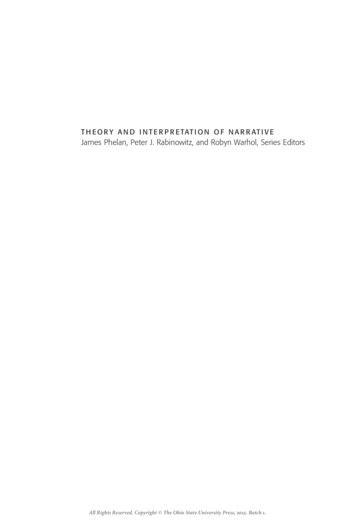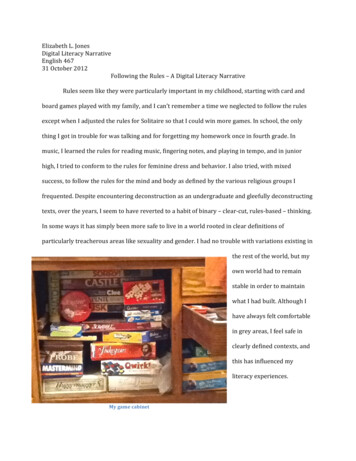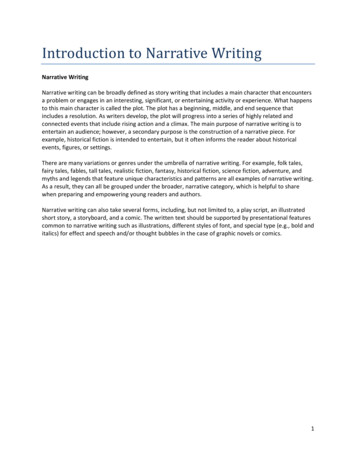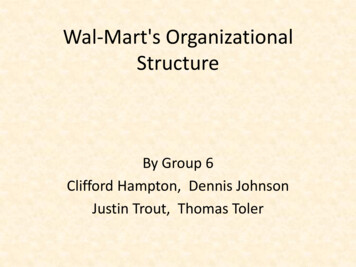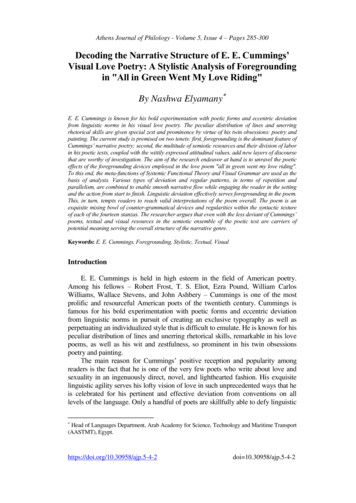
Transcription
Athens Journal of Philology - Volume 5, Issue 4 – Pages 285-300Decoding the Narrative Structure of E. E. CummingsʼVisual Love Poetry: A Stylistic Analysis of Foregroundingin "All in Green Went My Love Riding"By Nashwa Elyamany E. E. Cummings is known for his bold experimentation with poetic forms and eccentric deviationfrom linguistic norms in his visual love poetry. The peculiar distribution of lines and unerringrhetorical skills are given special zest and prominence by virtue of his twin obsessions: poetry andpainting. The current study is premised on two tenets: first, foregrounding is the dominant feature ofCummings’ narrative poetry; second, the multitude of semiotic resources and their division of laborin his poetic texts, coupled with the wittily expressed attitudinal values, add new layers of discoursethat are worthy of investigation. The aim of the research endeavor at hand is to unravel the poeticeffects of the foregrounding devices employed in the love poem "all in green went my love riding".To this end, the meta-functions of Systemic Functional Theory and Visual Grammar are used as thebasis of analysis. Various types of deviation and regular patterns, in terms of repetition andparallelism, are combined to enable smooth narrative flow while engaging the reader in the settingand the action from start to finish. Linguistic deviation effectively serves foregrounding in the poem.This, in turn, tempts readers to reach valid interpretations of the poem overall. The poem is anexquisite mixing bowl of counter-grammatical devices and regularities within the syntactic textureof each of the fourteen stanzas. The researcher argues that even with the less deviant of Cummings’poems, textual and visual resources in the semiotic ensemble of the poetic text are carriers ofpotential meaning serving the overall structure of the narrative genre.Keywords: E. E. Cummings, Foregrounding, Stylistic, Textual, VisualIntroductionE. E. Cummings is held in high esteem in the field of American poetry.Among his fellows – Robert Frost, T. S. Eliot, Ezra Pound, William CarlosWilliams, Wallace Stevens, and John Ashbery – Cummings is one of the mostprolific and resourceful American poets of the twentieth century. Cummings isfamous for his bold experimentation with poetic forms and eccentric deviationfrom linguistic norms in pursuit of creating an exclusive typography as well asperpetuating an individualized style that is difficult to emulate. He is known for hispeculiar distribution of lines and unerring rhetorical skills, remarkable in his lovepoems, as well as his wit and zestfulness, so prominent in his twin obsessionspoetry and painting.The main reason for Cummings’ positive reception and popularity amongreaders is the fact that he is one of the very few poets who write about love andsexuality in an ingenuously direct, novel, and lighthearted fashion. His exquisitelinguistic agility serves his lofty vision of love in such unprecedented ways that heis celebrated for his pertinent and effective deviation from conventions on alllevels of the language. Only a handful of poets are skillfully able to defy linguistic Head of Languages Department, Arab Academy for Science, Technology and Maritime Transport(AASTMT), Egypt.https://doi.org/10.30958/ajp.5-4-2doi 10.30958/ajp.5-4-2
Vol. 5, No. 4Elyamany: Decoding the Narrative Structure of E. E. Cummingsʼ norms to this degree, yet none approach his ability. For scholars interested indescribing and scrutinizing the aesthetic value and use of language, the visual lovepoetry of Cummings is a rich arena and an irresistible challenge.Literature ReviewThe poetry of E. E. Cummings appeals to researchers and scholars of variousdisciplines, who are linked through being stylisticians. His eccentric treatment ofthe English language is so intriguing and baffling that it calls for carefulexploration, interpretation, and evaluation. Cummings’ linguistic idiosyncrasiesare attributed to his twin obsessions which reveal themselves in textual and visualmodes in almost all his works. Of all his peculiarities, linguistic deviation is hismost prominent means of realizing foregrounding and achieving aesthetic value.A large body of research in the literature to date is dedicated to stylisticanalyses of Cummings’ poetry and capitalizes on observable patterns on differentlinguistic levels (Espák 2012, Moe 2011, Wang 2012). Most studies, however,tackle Cummings’ poetry only anecdotally, placing emphasis on the meticulouslyselected semantic, syntactic, lexical, and graphological deviations that producepowerful visual impressions on the readers. Examples are studies on: syntax(Berutti 1970, Cureton 1979a, 1979b, Fairley 1971, 1975, Lord 1966); morphology(Cureton 1979b, Fairley 1975); typography (González Mínguez 2010, Tartakovski2009); unconventional spelling (Alfandary 2002, Heusser 1997, von Abele 1955,Webster 1995); newyorkese in Cummings’ poems (Friedman 1960); unorthodoxorthography and voice rendering (Cureton 1986); and punctuation marks (GómezJiménez 2015a, 2015b, 2017). Literary scholars, on the other hand, have madeconsiderable contributions to the understanding of Cummings’ themes, imageries,visual representation, historical and biographical background, and traditionalpoetic devices, but have devoted little time to the more deviant aspects of hislanguage. As a result, the effectiveness and systematization of a large portion ofCummings’ deviant language remains unexplained.Theoretical BackgroundForegrounding in PoetryIn broad terms, stylistics is the study of literary discourse in relation to thelinguistic forms writers purposefully employ in their literary works. Operating onall linguistic levels, stylisticians are preoccupied with the analysis of both style andstylistic variation. Poetic style, as a deviant form of the norm, relates to all theeccentric linguistic inclinations permitted by poetic license. In Stylistics, the notionof foregrounding, the term advanced by the Prague School of Linguistics, iseffectively referred to as "artistically motivated deviation" by Leech and Short."Foregrounded features are the parts of the text which the author, consciously orunconsciously, is signalling as crucial to our understanding of what he has written." (Short 1996: 36).286
Athens Journal of PhilologyDecember 2018Foregrounding theory fundamentally advocates that poetic language deviatesfrom linguistic norms and this deviation hinders communication (see e.g., Kidder1979, van Peer 1986, 1987, Miall and Kuiken 1994). Nonetheless, native speakersof a language render these oddities stylistically marked and highly communicative.Apart from being noticeably visible, these perceived incongruities serve as anattention-drawing device in a literary text, which prompt readers to interpret them.Having spotted such deviant aspects, curious readers ponder the choice offormulation. Short (1996: 36-58) argues that deviation occurs on seven levels:discoursal (e.g., beginning in the middle); semantic (e.g., paradox, metaphor, etc.);lexical (e.g., neologism, functional conversation, etc.); grammatical (e.g., inversion,ellipsis, etc.); morphological (e.g., playing with morphemes such as in the poetryof Cummings); phonological (e.g., alliteration, assonance, etc.); and graphological(e.g., oddities in the written presentation of the text).In literature, foregrounding is created via the construction and exploitation ofpatterns and systems within language use, and perceived deviation from thosepatterns. Parallels can be fashioned through patterning and repetition of structures(as in rhyme schemes and repeated syntactic positioning), prompting the reader toseek semantic associations and interpretative links between the paralleled features.That is, foregrounding is realized by linguistic deviation and parallelism (Leech2008, Leech and Short 2007). Short (1996) draws upon a clear division betweeninternal and external deviation. Internal deviations are identified within the textitself, whereas external deviations relate to the established norms of the language,or the literary genre.Multimodal Discourse AnalysisMultimodal Discourse Analysis (MDA) is an evolving paradigm extensivelydeliberated on in the studies of discourse and semiotics. MDA adds newdimensions to the study of language relative to a multitude of semiotic resources,notably images, symbols, gestures, motions, and sound (O’Halloran 2011). It isnoteworthy that a multimodal account does not lay emphasis on one semioticfeature at the expense of another; rather, it identifies the wide spectrum of meaningmomentums and potentials such semiotic features afford when co-deployed in theprocess of meaning-making.Halliday (1978) purports that texts simultaneously fulfill three broad metafunctions – the ideational, the interpersonal, and the textual – which are mostlyrealized through the systems of transitivity, mood, and thematic structure,respectively. Parallel to Halliday’s are Kress and van Leeuwen’s (1996, 2006)meta-functions that their Visual Grammar model largely encompass. According tothem, in the same manner as does language, images fulfill the meta-functions ofrepresenting the experiential world (i.e., representational meaning), the interactionbetween the participants represented in a visual design and its viewers (i.e.,interactive meaning), and the compositional arrangements of visual resources (i.e.,compositional meaning). In this study, following Halliday and Matthiessenʼs(2014) Systemic-Functional Grammar (SFG), the systems of "transitivity","mood", and "thematic structure" are examined in the textual analysis. Based on287
Vol. 5, No. 4Elyamany: Decoding the Narrative Structure of E. E. Cummingsʼ Kress and van Leeuweenʼs (1996, 2006) Visual Grammar (VG), the visualanalysis examines: the representational meaning in terms of "narrative" processes;the interactive meaning in light of "size of frame" (social distance); and thecompositional meaning with respect to "information value" (placement), "framing"(connectedness), and "salience".Born within the framework of critical discourse studies, multimodality hasdeveloped into a rapidly emerging interdisciplinary field (Jewitt 2005). Theinterplay of poetry and multimodality is indisputable, particularly in the visualpoetry of Cummings. Only in recent years has a fair amount of research beengeared toward the study of multimodal theories on poetry interpretation, and thusfar Cummings’ visual poetry has received inadequate attention (Wang 2012).Although Visual Grammar is primarily developed for the study of static images,the model can still be put to test in the works of Cummings, particularly his visualpoems with their extreme deviations and eccentricities. This is where the presentstudy fills the gap in the literature to date and is, therefore, a keystone for asystematic multimodal-stylistic analysis of E. E. Cummings’ "all in green went mylove riding" (1916) that the researcher embarks on. It is part of a project initiatedby the researcher to revolutionize the study of Cummings’ visual poetry inmultimodal terms, hence drawing on a myriad of vibrant patterns of meaning.Research QuestionsPremised on the assumption that foregrounding is the dominant feature ofpoetry, the current study aims to answer the following research questions:1. What are the poetic effects of the linguistic devices employed forforegrounding in Cummings’ "all in green went my love riding"?2. What are the affordances of a Systemic-Functional Multimodal DiscourseAnalysis to Cummings’ "all in green went my love riding"?General Interpretation of the PoemCummings studied classical languages at Harvard, but he spoke often in hispoems the medieval tongue of courtly love. Nowhere does he weave moregracefully these ancient and merrily old threads than in the textual tapestry of "allin green went my love riding" (see Appendix A). This luminous and initiallyperplexing text is a love poem. Although the fact is not overtly elucidated, it is anelaborate metaphor about courtship and undertaking the consequences thereof. It isan allegory to and a subtle narration of an ancient fable featuring the Romangoddess of the hunt, riding off at the break of dawn in the company of her sacredanimals.The female hunter throws down the gauntlet regarding the speaker’s ventureto pursue her and so she has him, metaphorically, killed. The poem is set infourteen stanzas, each of which graphically chronicles a different phase of the288
Athens Journal of PhilologyDecember 2018grand chase, i.e., courtly love. "All in green went my love riding" is not toocomplex a poem to grasp in terms of its underlying theme. What is challenging forreaders is to relate the plethora of stylistic and multimodal features that Cummingsgracefully interlaces in the poem to plausible explanations.Indeed, Cummings takes all kinds of detours along the way, lingering todescribe the running deer, the crouching hounds, and the valleys through whichthey journey. There seems to be a twofold thread weaving through the poem: anarrative account of human love and a dazzling exhibition of natural beauty.Readers begin to appreciate the theme when gazing at the most foregroundedfeatures of the poem; that is, the bits of the poem that stand out because they seemunusual. "All in green went my love riding" is a fine exemplar of Cummings’extreme boldness in manipulating the conventions of the English language anddeviating from the norms in attempt to conceal more complex shades of meaningthan found in merely a simple ballad. Indeed, the dexterous use of foregroundingdevices and semiotic resources helps to elevate the theme of the poem inunprecedented ways.AnalysisStylistic AnalysisUnequivocally, a linguistic deviation is a disruption of the normal processesof communication, leaving a gap in one’s comprehension of the text. Leech (1969:10-12) posits that any deviation from linguistic norms leads to reactions ofbewilderment. This deviation, nonetheless, can be rendered significant only whenreaders exert conscious effort to perceive some deeper connection thatcompensates for the discernible oddity. A deviant linguistic feature a priori doesnot exist in isolation; rather, it intermingles with other linguistic cues on intratextual and extra-textual planes. In this section, the researcher examines deviationon the discoursal, graphological, semantic, and syntactic levels, delving into howthey contour the emotional experience of courtly love. To facilitate the analysis,each line of the poem is numbered (see Appendix A). The analysis is restricted tothe linguistic features that are relevant and prominent. Where appropriate,plausible interpretations associated with each feature are introduced for subsequentevaluation of the poem.In discourse terms, researchers can adequately account for much poetry anddeal with it via the "direct address" mode – i.e., the prototypical addressermessage-addressee situation. However, this is not always the case, particularly inthe poem under study. It is quite ambiguous whether the addresser in "all in greenwent my love riding" is the poet or a persona. Is Cummings narrating a personalexperience by means of an allusion to an old myth? Is he placing himself in theposition of a lover he knows, detailing how he is a victim of love? Is he themouthpiece and ambassador of love by and large? Although the poem takes thefirst person point of view, as indicated by the possessive my in "all in green wentmy love riding" and "my heart fell dead before", readers are baffled and have no289
Vol. 5, No. 4Elyamany: Decoding the Narrative Structure of E. E. Cummingsʼ clue if the speaker is the poet or some persona. Apart from anything else, thespeaker in the poem unveils the multiple phases of the narrative as though he werean observer and a commentator on the scene.The multiple-addresser mode instantiated by Cummings is well deployed inthe poem at hand. Cummings is interested in the entirety of language and in thefull range of its potential rather than in its narrow, conceptual aspect. He managesto engage readers in the storyline, calling their attention to the fine details of thechase as the poem unfolds by means of incarnating all potential lovers in the broadsense of the word. Cummings is a strong advocate of human rights and, other thanhis desire to break the conventions of the language, this type of discoursaldeviation, at the macro level, is a way of foregrounding humility and equalityamong people.An interesting typographic convention of poetry, one in which both externaland internal deviation may be produced, governs the use of initial letters in a line.The general practice is to begin each line of a poem with a capital letter, producingin this way an external deviation. To make poetic texts more familiar to the nakedeye of modern readers in the twentieth century, the typographic idiosyncrasieshave been normalized in Cummings’ poetry as will be seen in what follows. Inbreaking with the tradition in "all in green went my love riding", he goes on toexploit his convention by beginning an occasional (though not a random) line witha capital, thus producing an internal deviation. Punctuation, typeface, linearrangement, and spelling are all physical features that participate in the creationof meaning. Leech and Short (1981: 131) advocate: Graphological deviation is arelatively minor and superficial part of style, concerning such matters as spelling,capitalization, hyphenation, italicization, and paragraphing. Such matters aredetermined conventionally by syntax and become noticeably expressive only whena writer makes a graphological choice, which is to some degree marked orunconventional, such as a deliberate misspelling.To Cummings, orthography shapes the impromptu experience of love. Acursory look at "all in green went my love riding" reveals that all the lines of thepoem (not excluding the title) are in lower-case except for line-initials of eachstanza. Cummings’ practice represents a deviation not only from the poeticconvention but from the external norm of ordinary language use as well. Heresorts to capitalization, but he de-automatizes its usage in order to make a poeticchoice out of it. To him, each stanza is a unity detailing a different phase of thechase, marked as it is by the initial capital in the first line of each. He disregardstypographic conventions to foreground the speaker’s lover and the grand chase.Interestingly, full stops at the end of each stanza are mostly employed forrhythmical purpose. In brief terms, Cummings’ effective breach of orthographicnorms validates the fact that punctuation marks are amenable to appropriation,exploitation, and projection as shown in later examples as the analysis unfolds.Metaphor in poetry, in its wider sense, is the process whereby literal absurdityleads the mind to comprehension on a figurative plane (Leech 1969). It is by farthe most important single factor in that transcendence of the normal resources ofcommunication by which poetic language is characterized. In "all in green wentmy love riding", several metaphors are deliberated by Cummings to draw290
Athens Journal of PhilologyDecember 2018memorable portraits of the beauty of the landscape and setting where the grandchase takes place. Examples are: "horse of gold", "silver dawn", "hounds smiling", "merry deer", "arrow sang", "peaks ran", and "riding the echo". In fact,the poem is saturated with language that appreciates the beauty of the naturalworld, and the humans who trample through it.Exquisitely, the very crux of "all in green went my love riding" is a pun andthe pun happens to play upon the very relation between man and animal. Thepoem springs from an extended metaphor of the speaker’s heart in the deer vividlydescribed from start to finish. All the alliterative pairs of adjectives describing thedeer might also be typically applied to human life, as in "swift sweet", "red rare","tall tense", and "sleek slim". The last line of the poem, at its core, is a metaphor –in "my heart fell dead", the speaker is not referring to literal death. Rather, he isrelating it to the theme of courtly love. Cummings’ unconventional presentation ofverse leaves readers mesmerized in a world of spontaneity, liveliness, fantasy, andtimelessness. The ebullient metaphors deftly interwoven in the verse are part andparcel of Cummings’ aesthetics that foreground the theme of love.Cummings particularly enjoys experimenting with the syntactic conventionsof the English language. His poetry is suffused with odd grammar anddisconcertingly strange word ordering. Inverted syntax is one prominent freedomCummings enjoys in "all in green went my love riding". In line 1 of the poem, thesubject-verb inversion is realized to foreground the dramatic effect. Repeating thesame inverted structure in line 11 emphasizes the point that the act of riding (andin turn the chase) is the principal action in the poem. Another interesting instanceof inversion is in lines 9 and 10, which should be read as line 10 then line 9 toconform to English syntax. The switch foregrounds the deer as the center ofattention. Similarly, the inversion in lines 19 and 20 parallels that in lines 9 and 10;that is, to conform to English syntax, they should be read in a reversed sequence,where the arrows chase the deer. The reversed order in the aforementioned accountdraws readers’ attention to the motion and perhaps the speed of the arrow targetingthe deer, hence accelerating the scene and the imminent end.In addition to the inverted syntax, impermissible structures are in use as in "bethey" in "fleeter be they than dappled dreams", which should read "they are fleeterthan dappled dreams". Not conjugating the verb "to be", the poet perpetuates theimagery of the running deer. The deer, in this sense, is in motion so far in thepoem. The syntactic abnormality in this example is far from being a hindrance tocommunication. Intentionally, it conveys a bit of information – i.e., theprogression or timelessness of the action, which the poet foregrounds. Similarly, inline 26, the verb "to be" is not conjugated but for a different purpose; "paler bethey than daunting death" should be "they are paler than daunting death"; thisdeviation marks a shift in the deer’s state. The deer appears to be paler than death,hence foreshadowing his looming tragic end. To sum up, Cummings’ idiosyncraticgrammar recurs in different stanzas of the verse to call readers’ attention to thesetting and the many actions taking place at different phases in the hunt scene.291
Vol. 5, No. 4Elyamany: Decoding the Narrative Structure of E. E. Cummingsʼ Multimodal AnalysisCummings’ penchant for linguistic estrangement, typographical play, and thecreation of movement and experience make his poetic texts a rich arena for amultimodal analysis. In this section, the researcher unravels the textual and visualmake-up of "all in green went my love riding", identifying the semiotic resourcesthat advance foregrounding and further the theme of the poem.In Hallidayan terms, the ideational meta-function is the "content function oflanguage" (Halliday 2007: 183) and is primarily realized through the system oftransitivity that details the very types of processes (material, mental, behavioral,etc.) that represent situations and events in the world. The transitivity choices inthe poem point out how the participants in the poetic text are represented. Eachtwo-line stanza in the poem is buzzing with action, depicting a different phase ofthe chase. There seems to be a clear pattern that is worth dwelling upon.The majority of the processes are "material" in type, with the poet, his love,and the animals in her company as participants in the role of "actor". The materialprocess verbs are put to good effect so as to fit into the adventurous scene, despitethe fact that some of these verbs are used metaphorically with inanimate entities.Examples to note are "went my love riding", "hounds crouched", "the merry deerran", "bugle sang", and "meadows ran". Static in this flux, an insistent refrainrepeated once for each dog, are "four lean hounds crouched low and smiling".Unmoving, uncolored and perpetually still in the midst of all actions, these houndsare backgrounded to foreground the actions in the poem.On a related note, the poet makes effective use of circumstantial adjuncts ofdifferent types: location (e.g., "on a great horse of gold"), place (e.g., "at a whitewater"), and manner (e.g., "horn at hip", "bow at belt", and "low and smiling"),falling into different places in the stanzas (at the beginning, or at the end). They allorchestrate to not only weave the ballad together, hence producing a unity, but toalso sequence the transitivity choices made by the poet. The overall transitivityprofile unravels the actions of the ballad one at a time and serves in foregroundingthe grand chase.The interpersonal meta-function, according to Halliday, is the "participatoryfunction of language" and is primarily realized through the systems of mood. Thepoem is set in fourteen stanzas, each of which portrays a graphic phase of thechase, i.e., courtly love. The language of the poem parallels these phases, startingoff with gentle imageries, ending up with creepy accounts. Each stanza, line, andword calls for illumination with respect to the context in which it occurs. Eventhough the poem is laced with ferocity, readers are flabbergasted when the actualprey turns out to be the lover. The poet recites the narrative through binoculars asthough he were an observer and commentator on the scene. This, in turn, engagesreaders in the ballad, shortening the distance between the poet and readers, hencemaking them feel that they belong to the same discourse community, i.e., lovers atlarge.Specific lines offer little difficulty, though. Shortly after a courtly start (the"green", "gold" and "silver" of stanza 1, which may fancifully suggest medievalillumination) the poem becomes ominous with suggested conflict. Stanza 2,292
Athens Journal of PhilologyDecember 2018juxtaposing sinister hounds and merry deer, sets sympathies as well as sides. Line6 underscores them. When "my love" is identified as a hunter by the "cruel bugle"of line 10, a dilemma becomes apparent. With the second quatrain, the huntquickens. Ground shifts from a "white water" to "level meadows" and a "goldvalley". The equipment of the chase is the "famished arrow". The final ten linesbring to a climax both the chase and the dilemma. The ground rises to "sheerpeaks" and a "green mountain". The tired deer, now within range, are "paler.thandaunting death".The implication of this allegoric hunt, the upshot of this mixture of tapestry,linear exposition, and graphic concept, lies in the poem’s movement. From theoutset, readers are caught in a dreamlike flux of color, landscape and even gender.In the half-light of dawn, "green", "gold", "silver", "red", and "white" flash past.Terrains alter, and even the deer changes from "roebuck" to "does" to "stags". Thisnarrative technique is particularly useful in this poem because its frame effect, thesuspense-creating discontinuity that forms and informs tapestry, snaps suddenly asa clicked shutter to reveal the hero’s unexpected "death".It is in the textual function that ideational and interpersonal meanings areactualized (Halliday 2007: 184) and essentially realized through the systems ofcohesion and thematic structure. Pattern making is one of the striking features ofpoetic language that encompass the systems above. Pattern making in poetry canbe called "extra-regularities" and a poet goes beyond the regular patterns oflanguage for the sake of foregrounding. Numerous instances of lexical repetitionare easily traced in the ballad. First, the title – being the first line of the poem –takes the reader straight into the heart of the poem, with its sonic repetition, andthe fascinating graphic portraits that recur throughout as the narrative flows. Fromthe start, readers are at the heart of the scene, enjoying the ride and following thechase.Stationary amidst this movement are "four lean hounds crouched low andsmiling" – an insistent refrain in stanzas 2, 6, 10, and 14. As indicated earlier,representing them as motionless in the midst of all the buzzing actions foregroundsthe hunting scene; the dogs are part of the setting signaling that a hunt isunderway. A final striking instance of repetition is stanza 13, which is the same asstanza 1. While stanza 1 marks the beginning of the hunt, stanza 13 marks theclosure of the story and the chase, bringing readers in a full circle. At this point ofthe poem, readers are left in anticipation of the end: will the chase end merrily ortragically? Repetition so far is employed to startle readers with unexpected twistsin events.From another angle, to organize the theme of the poem and the progression ofthe chase, the poet makes effective use of the theme and rheme. In English, thetheme is realized by what is placed in the first position within the clause, and thushas a special status. What Cummings chooses to thematize in each stanza relates tothe poet’s love (e.g., "all in green", "horn at hip", and "bow at belt"), otherparticipants in the scene (e.g., "four lean hounds", "four fleet does", "four tallstags", etc.) or comparatives that describe them (e.g., "fleeter", "softer", and"paler"). This pattern is intended as a constant gentle reminder of the peacefulcompany that escorts the speaker’s love in the journey from start to finish.293
Vol. 5, No. 4Elyamany: Decoding the Narrative Structure of E. E. Cummingsʼ The representational meaning can be achieved through the visual constructionof the nature of events, the objects and participants involved as well as thecircumstances in which they occur. Visual poetry treats the page design as acanvas to represent the themes, participants, or emotions in multiple ways. Thevery typographical arrangeme
poems the medieval tongue of courtly love. Nowhere does he weave more gracefully these ancient and merrily old threads than in the textual tapestry of "all in green went my love riding" (see Appendix A). This luminous and initially perplexing text is a love po

